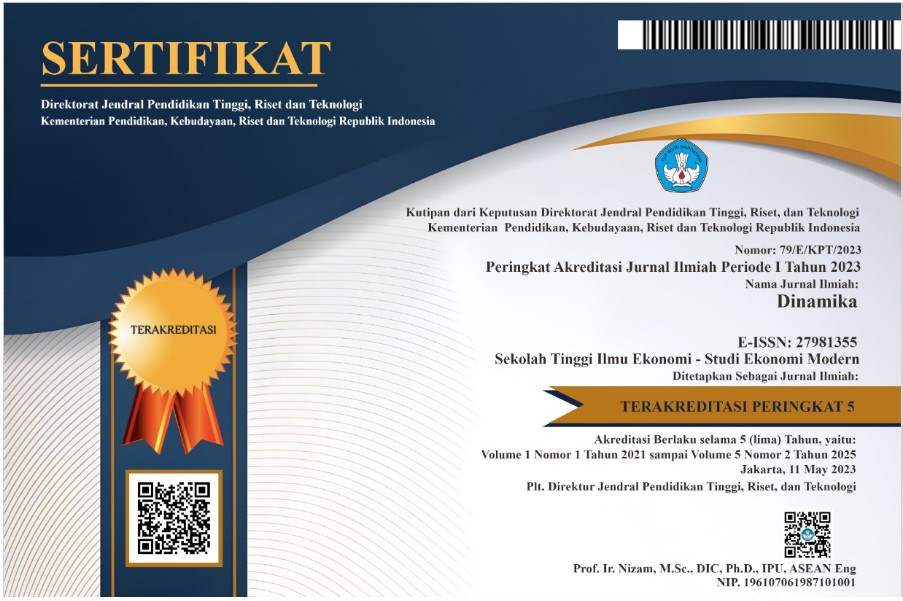BERADAPTASI DENGAN PERUBAHAN PASAR DALAM STRATEGI BERSAING YANG FLEKSIBEL DAN DINAMIS
DOI:
https://doi.org/10.51903/dinamika.v4i2.503Keywords:
Adaptation, Change, Competitive strategy, Flexibility, Market dynamicsAbstract
This research aims to identify flexible and dynamic business strategies in adapting to market changes. The research method used is qualitative descriptive with a literature study approach to understand ideas and theories relevant to the research topic. The analysis employed is descriptive analysis, which analyzes the data by describing or presenting the information without attempting to draw broad conclusion or generalization. Furthermore, Flexible and dynamic competitive strategies allow companies to not only adapt to market changes, but also take advantage of these changes to increase intelligence and business efficiency. These constraints include changes in the market, which are often accelerating, and companies respond slowly to market changes, thereby reducing adaptation and competition. A flexible and dynamic competitive strategy in changing markets would demonstrate that companies were able to successfully adapt to market changes, increase their capacity and achieve business success. This research is expected to help society, especially businesses, to determine flexible and dynamic strategies to adapt to changes in a market
References
[2] E. Wijayanti, “Perencanaan Sumberdaya Manusia Yang Efektif: Strategi Mencapai Keunggulan Kompetitif Erni Widajanti Fakultas Ekonomi Universitas Slamet Riyadi Surakarta,” J. Ekon. Dan Kewirausahaan, vol. 2, no. 2, pp. 105–114, 2017.
[3] M. A. Maulana, “Pengaruh Dinamisme Lingkungan, Kemampuan Dinamis, dan Literasi Keuangan terhadap Kinerja UMKM di Kota Mojokerto,” J. Ilmu Manaj., vol. 9, no. 2, pp. 559–570, 2021, doi: https://doi.org/10.26740/jim.v9n2.p559-571.
[4] A. Prasetia, “Faktor-Faktor Yang Mempengaruhi Persaingan Dan Pertumbuhan Pasar: Budaya, Sosial, Personal (Suatu Literature Review),” J. Ilmu Manaj. Terap., vol. 2, no. 4, pp. 442–462, 2021, doi: https://doi.org/10.31933/jimt.v2i4.457.
[5] P. Dwi Prasetyo and L. Prayogi, “Analisis konsep dinamis pada elemen arsitektur bangunan fungsi campuran,” J. Archit. Des. Dev., vol. 1, no. 1, pp. 1–13, 2020, doi: https://doi.org/10.37253/jad.v1i1.704.
[6] F. F. Sugiarto, “Analisa Strategi Bersaing PT. Surya Cipta Mandiri,” Agora, vol. 4, no. 2, pp. 250–258, 2016.
[7] K. Krisnando and R. Novitasari, “Pengaruh Struktur Modal, Pertumbuhan Perusahaan, dan Firm Size terhadap Nilai Perusahaan Pada Perusahaan Consumer Goods yang Terdaftar di Bursa Efek Indonesia (BEI) Periode 2017-2020,” J. Akunt. dan Manaj., vol. 18, no. 2, pp. 71–81, 2021, doi: https://doi.org/10.36406/jam.v18i02.436.
[8] Sugiyono, Metode Penelitian Pendidikan Pendekatan kuantitatif, Kualitatif, dan R&D. Alfabeta, 2016.
[9] W. Obon and S. Sugiono, “Mengembangkan Kualitas Strategi Bersaing Yang Berdampak pada Kinerja Perusahaan (Studi pada UKM Penggilingan Batu Putih di Kabupaten Pati dan Jepara),” 2014.
[10] R. P. C. Hanggana, “Pengaruh fleksibilitas strategi terhadap kinerja perusahaan (studi pada kud tani Wilis kecamatan sendang kabupaten tulungagung),” J. Ilm. Mhs. FEB, vol. 5, no. 2, pp. 1–14, 2017.
Downloads
Published
Issue
Section
License
Copyright (c) 2024 Dinamika: Jurnal Manajemen Sosial Ekonomi

This work is licensed under a Creative Commons Attribution-ShareAlike 4.0 International License.












